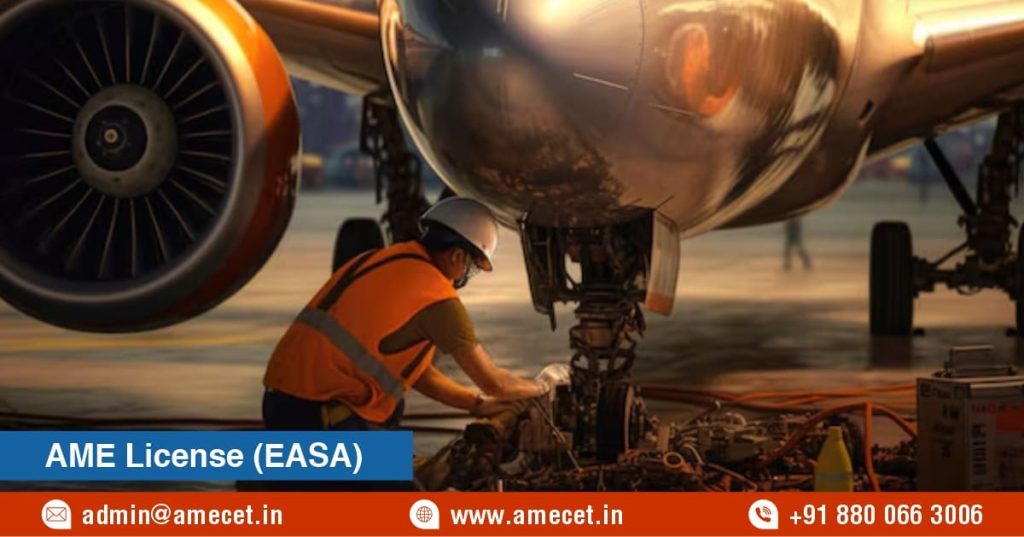How to become an AME EASA license holder?
Posted on : 15 January, 2024 3:27 pm
AME license (EASA)
The AME License (EASA) course, overseen by the European Aviation Safety Agency, focuses on aircraft maintenance and repair. As aircraft maintenance engineers, individuals play a crucial role in ensuring airworthiness, conducting repairs, inspections, and upgrades. With a rising number of air travelers, this is an ideal time for passionate students to pursue a rewarding career in aviation. The course offers excellent career prospects in a dynamic industry where no aircraft can take off without approval from a licensed aircraft maintenance engineer.
Eligibility Criteria:
- Educational requirements: Complete your high school education with Physics, Chemistry, and Mathematics as subjects.
- Age criteria for admission: Candidate age must be between 16 to 28 years at the time of admission.
- Entrance exam: Take the aircraft maintenance engineering Common Entrance Test (AME CET) to secure admission in top institutions.
AME (EASA) Course Stream
Aircraft Maintenance Engineering course stream classified in the following categories:-
A License:
A license category is further classified in the following categories which are as follows:-
- A1 License:- A1 license allows maintenance, repair, and solve the simple defects of an aeroplane with the jet engine.
- A2 License:- A2 license allows maintenance, repair, and troubleshoot of the simple defects of an aeroplane with the piston engine.
- A3 License:- A3 license certifies the maintenance, repair, and solve the simple defects of a helicopter with the jet engine.
- A4 License:- A4 license certify the maintenance, rectify, and troubleshoot the simple defects of a helicopter with the piston engine.
B1 License:
B1 licensed AME has to rectify and solve the issues regarding the mechanical parts of an aircraft. The subcategories of B1 license is as follows:-
- B1.1 License:- B1.1 licensed AME has to certify the mechanical parts of an aeroplane with the jet engine. The mechanical parts can be engine, fuselage, landing gear, etc.
- B1.2 License:- B1.2 licensed AME has to maintain, repair, and solve the issues of an aeroplane with the piston engine.
- B1.3 License:- B1.3 license holder has to maintain, repair, and troubleshoot the issue of helicopter with the jet engine.
- B1.4 License:- B1.4 license holder has to maintain, repair, and solve the problems occurs in a helicopter with the piston engine.
B2 license:
B2 license commonly known as “avionics”. This license holder allows to maintain, repair, and troubleshooting the issues related to the electronic parts of an aircraft. The subcategories of B2 license is as follows:-
- Electrical system
- Radio and Navigation system
- Instrumental system
Admission criteria
The admission process for the Aircraft Maintenance Engineering (AME) course under EASA typically involves the following steps:
- Meet the Eligibility Criteria: Candidates must meet the eligibility criteria set by EASA, which usually includes completion of 10+2 with Physics, Chemistry, and Mathematics as mandatory subject
- Appear for an Entrance Exam: Candidates will be required to appear for an AME CET Entrance Exam specific to the ame course they are applying for.
- Attend an Admission Counselling: Candidates will be required to attend an admission counselling conducted by AME CET as part of the admission process.
- Pay the fees: Once the candidate has cleared the entrance exam and the counselling, they will be required to pay the fees to secure their admission.
AME (EASA) Course Duration
Aircraft Maintenance Engineering course duration is of 4 years, which includes 2 years academic program and 2 years of practical training. The theoretical knowledge will be gathered at EASA approved AME institute and live training will be held in EASA approved organization.
Complete Academic Program (2 years):
- Attend theoretical classes at the AME institute: Engage in classroom sessions to gain theoretical knowledge related to aircraft maintenance.
- Pass module exams for your chosen stream (A or B): Successfully pass module exams relevant to the chosen stream (Category A or Category B).
Undergo Practical Training (2 years):
- Gain hands-on experience at an EASA-approved organization: Acquire practical skills by working on actual aircraft at an EASA-approved organization.
- Earn a stipend while acquiring practical skills: Some organizations may provide a stipend during the practical training period.
- Get your work experience verified by certifying staff: Have your practical experience verified by certifying staff members to ensure it meets EASA requirements.
Apply for Licensing:
- Submit your application and required documents to the National Aviation Authority (NAA) of your chosen EU member state.
- Fulfill any fee requirements associated with the application process.
- Once your application is approved, you’ll receive the EASA Part-66 aircraft maintenance license without type rating.
Optional: Obtain Type Rating (for specific aircraft types):
- Complete type training and assessments at an EASA-approved organization.
- Successfully complete theoretical and practical exams related to the specific aircraft type.
- For your first type rating, undergo on-the-job training under supervision.
- Have your EASA Part-66 Aircraft Maintenance License endorsed with the specific type rating.
This step-by-step breakdown aims to provide a comprehensive understanding of the process, making it easier for aspiring AME EASA license holders to navigate their educational and professional journey. It provides a clear understanding of the process, simplifying the path to becoming certified Aircraft Maintenance Engineers.

